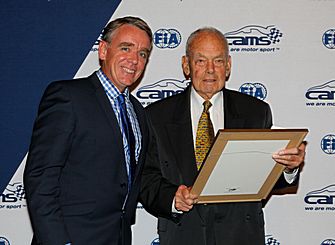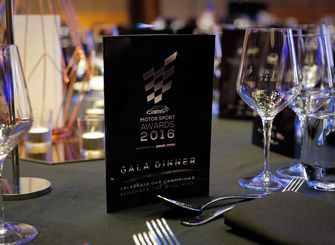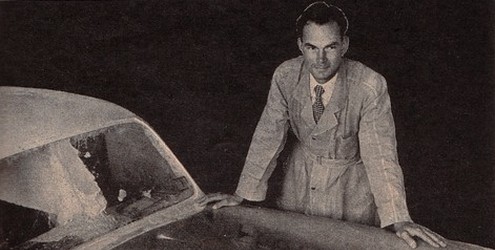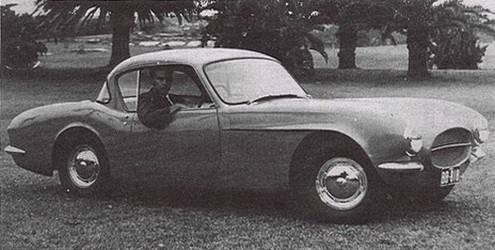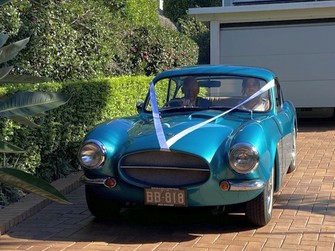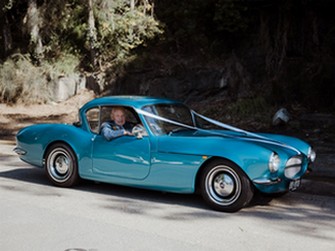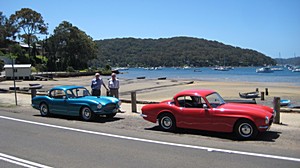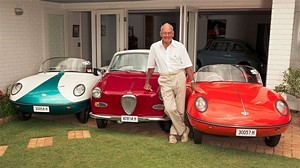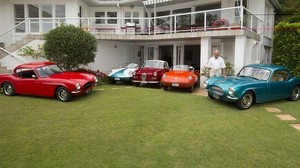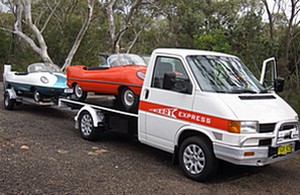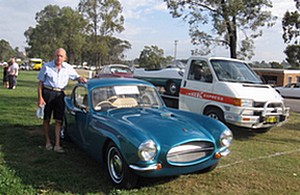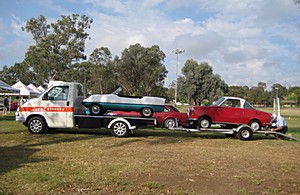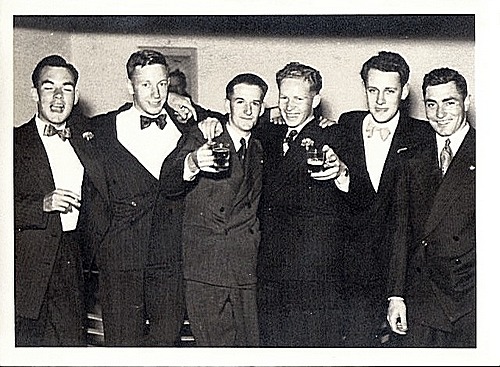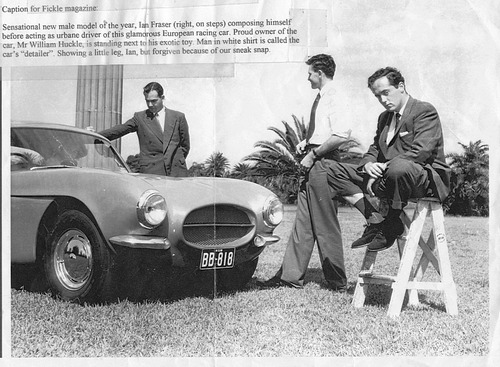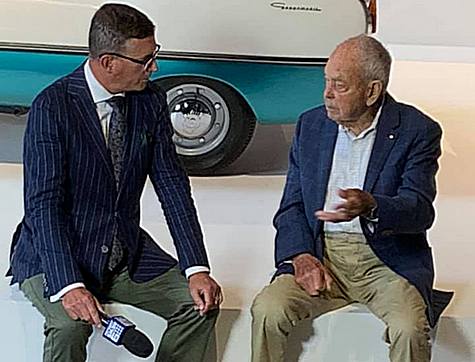|
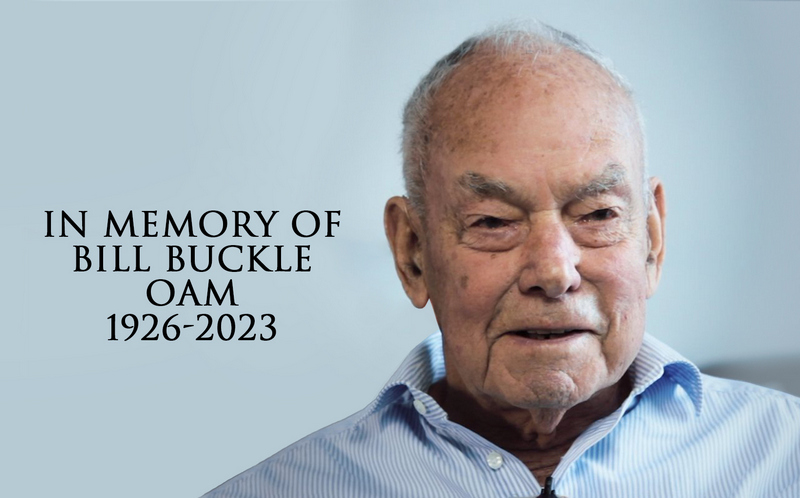
Bill passed away in 9th May 2023. Rest in Peace
BILL BUCKLE OAM (2014)
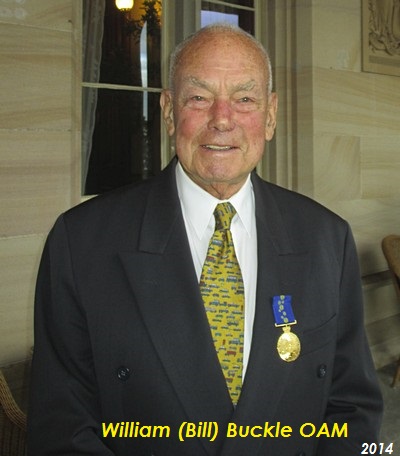
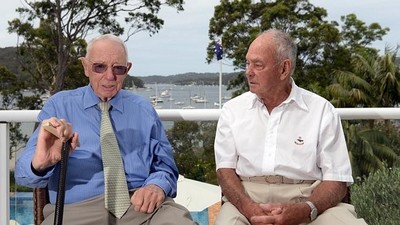
Bob Oatley and Bill Buckle have been friends for more than 80 years.
They have both been honoured today with the Order of Australia.
Bill Buckle has been awarded the Medal of the Order of Australia for his service to the motor vehicle industry as a designer and retailer.
Bob Oatley has been appointed an Officer of the Order of Australia for distinguished service to the Australian wine and tourism industries, to yacht racing and the community as a supporter of medical research and visual arts organisations.
Source: News Limited 26/1/14
"The Phil Irving Award for 2016"
Bill receiving his award for "Recognising his engineering excellence across an 60 year career.
Bill Buckle's Own Story
My father started a motor business in Sydney in the mid 1920s and was very successful in competitions with early Triumph cars, and he held the light car record from Sydney to Melbourne for many years. I remember going to Bathurst at age 12 with the family in 1938 to see Peter Whitehead win the Australian Grand Prix in an E.R.A. We went in a new Triumph Dolomite, which was pretty special at the time. Another car that fascinated me was the 1934 DeSoto Airflow, a radical shape for its day, and with overdrive was a genuine 100mph vehicle- dad took on the franchise!
I suppose these circumstances influenced my early interest in cars, and because the family had boats, I was used to rowing a dinghy, fishing and cruising Pittwater in a little motor sailer flat out at 6 knots!
My father's mechanic (and co driver) came back from the war and told me of a 1928 Triumph 7 chassis that he had under his house at Avalon. We retrieved it and got it going - I remember being apprehended by the Law driving along Balmoral promenade with just 2 bucket seats and no bonnet, on trade plates. It cost Dad a case of Scotch to get the plates back! I was serving an engineering apprenticeship at CSR Pyrmont at that time, and together with a friend Charles Buck, and access to the Spare Parts Dept. at Buckle Motors, we put together a very pretty and competitive little sports car that used to trouble the MGs and other specials at the hillclimbs.
Sailing became another passion after we converted the heavy ten foot clinker dinghy by fitting a centreboard, rudder and bowsprit, and buying mast, gaff and sails from an old sailing canoe. Balmoral boatshed was a hub for small boats sailing around Middle Harbour, and of course a bit of racing happened, then a few of us bought second hand 12 foot skiffs, and started the Balmoral 12 foot Skiff Club, building a club house (a new ex Army Nissen hut) on the edge of Balmoral Beach, (I think some of our relatives knew some of the Mosman Councillors!) Water Skiing became the next serious water sport and I put together a couple of ski boats, the last one with a Ford Zephyr motor lying on its side at the back of a Lewis fibreglass hull with a chain driven Vdrive, to keep the whole boat low and compact.
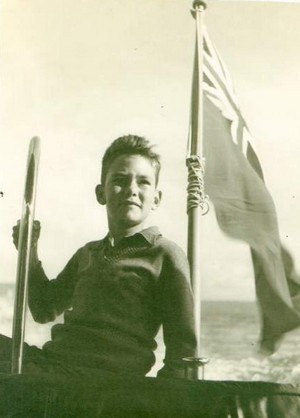 |
Young Bill's passion in sailing and motor racing and now a collector of Buckles and Goggomobils.
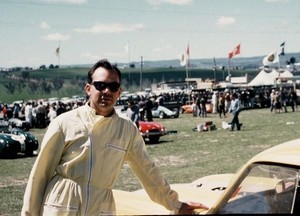
|
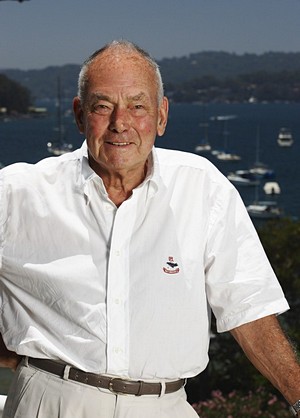 |
Back to motor sport, my Dad died when I was 19, and it was decided that I should join Buckle Motors to learn the car business. This made it necessary to break my apprenticeship (and lose the opportunity of making foreign orders for various boats and cars) but I got a good grounding in the Service Department at Kings Cross and Spare Parts in William Street. In 1949, the Company got the opportunity to take on the Citroen franchise. I went to Adelaide with Bill Lowrie (Dads former mechanic / service manager), who by now was Managing Director, to bring a Citroen Light 15 back to Sydney. We were very impressed with this innovative front wheel drive car, and I could see the potential of a bit of motor sport! I raced one and competed in hill climbs and trials at all the major circuits and rally events, with considerable success. Charles Buck was the fearless navigator (and innovative repairer/tuner) and we discussed the idea of a FWD open wheeler. We were lucky to find an almost new Light Fifteen which had serious body damage but mechanically good and built a chassis using front and rear cross members, which carried engine/ transmission and suspension and steering. I sold it to get some money for the next venture, but it became a very competitive hillclimb car in the hands of subsequent owners.
About this time, the travel bug bit, and I decided to go to Europe to get some experience at the Citroen Factory in Slough, out of London and at a service centre in Central London. I was lucky enough to have a new home delivery Citroen Big Fifteen at my disposal and over the eighteen months, followed the Grand Prix events around Europe with drivers such as Moss, Hawthorn, Collins, etc, and participated in rallies in the UK. In 1953, a Melbourne friend phoned to ask if I would come back to Australia to co drive a Light Fifteen in the first Redex round Australia trial, an offer too good to refuse. The car had been prepared before I got back and I was surprised to learn that we were taking a third member to navigate while one driver got some sleep. This necessitated putting extra spare wheels and tyres on a roof rack, and too much weight for a small car. The next year, I went again in a Light 15 with just two drivers, but trying to pass a slower car in the dust in WA, we hit a rock that was a bit too high for the front suspension! This required a lot of innovation to make a rig using a length of chain, some shackles and a tyre lever, to lift the front enough to limp back to Mt Isa.
While in Europe, I had seen some fibreglass bodied sports cars, (mostly one off) and influenced by some very pretty Ferrari, Maserati, etc. sports cars and the English AC Ace and Austin Healeys, I convinced the board of Buckle Motors that we should build a prototype sports car using locally available components and experimenting with fibreglass. So began the task of designing and building the Buckle coupe. Ron Tauranac, whom I had known from hillclimb events, designed a chassis and suspension to incorporate Ford Zephyr parts, and we learned a lot about making a full size plaster model, to take a mould for the first body. We did a lot of miles in that car to prove the chassis, and when Charles Buck joined the Company, went on to re-design the body as a full 2+2 coupe and start production at Buckles large factory in Bonds Road, Punchbowl. The rest of this story has been well documented by the author of this website. The prototype was sold, then went to N.Z., then the UK and is now owned by a German enthusiast who has restored it better than new. I have seen it in Germany when visiting for the 50th Anniversary of Goggomobil in Bavaria, but thats another story.
In 1958, Buckle Motors needed a budget priced brand of car and having been offered the German Goggomobil, I went to the factory in Bavaria with photographs of the Buckle and our facility, and convinced the owner, Hans Glas, that we could build fibreglass bodies (copying their steel ones) to build cars using their mechanical and body hardware components. This saved a lot of duty and freight compared to fully built up vehicles, and we produced quite a lot of cars, including the Dart, which was my design, and has become somewhat of an icon due in part to the funny Yellow Pages ad that features a Scotsman trying to find parts for his GO, GGO and the Shannons Insurance advertisements. In late 1961, the opportunity to sell the Company was taken up. I looked around for something to do, as I had a young family to support, thought about buying or building a marina, but accepted an offer from a motor racing mate, Ron Hodgson, to join him in his used car business on Parramatta Road, a big eye opener for someone used to the comparatively genteel new car business of William Street. I used to go to the auctions to find some upmarket cars for the yard and in 1963 fell in love with a new left hand drive Chev Stingray at Auto Auctions. I took it home and together with my young employee, who had been with me since we built Goggomobils, converted it to right hand drive in the garage in about 10 days. The going price for the conversion was one thousand pounds, and a hundred pounds a day looked pretty good to us. We rented a small factory in Brookvale and so began Bill Buckle Auto Conversions, which quickly grew to quite a large business, turning out as many as four conversions a week. We also did invalid conversions and engine transplants etc, etc, and designed and built the Monaco body conversion for the Morris Mini. During this time, a new showroom had been built in Brookvale for a Datsun dealership. The deal somehow fell through and I was talked into taking it on. I spent my weekends and nights trying to buy used sports cars and upmarket American muscle cars to sell from there, but that became a full time job. I saw a 1964 Toyota Crown at the Motor Show and was so impressed I said those people will lead the world in cars in 10 years time . I wasnt quite right, but it did eventually come to pass. I took on Toyota, and from very slow beginnings, we came to be the first Toyota dealer to deliver 150 cars in one month. We subsequently gained Subaru, Audi and Volkswagen franchises, delivering up to four hundred cars a month including used cars. My children ran the business in recent years, and when an opportunity to sell it came along, we all decided we had been there, done that, and accepted the offer.
Back to boating. In the days of the Toyota franchise I saw the opportunity to sponsor the, by now, very fast and exciting 12 and 16 ft. Skiffs and in 1979 both the twelve foot Buckle Toyota and the sixteen foot Buckle Toyota won the National Championships. I went to the 16 footer titles in Perth that year and saw the full size model of a flybridge Randell 32 on the banks of the Swan River. I went to the factory and asked them to build one with just a windscreen and soft-top like a big speedboat. They agreed and asked if I would sell their boats on the East Coast, I agreed and we were quite successful in establishing the brand mostly in Sydney. I had spent a lot of time boating in the Mediterranean with a longtime friend, and had admired the big flushdeck runabouts from the mostly Italian boatyards, and thought they would work in Sydney. I built a 41 footer for myself and it won Boat of the year at the 1983 Sydney Boat Show, then sold one to Sydney Toyota dealer (and original Buckle Coupe owner) Peter Williamson. Although enjoyable, the boat business became a big commitment, and when another dealer became interested, I let it go to concentrate on the car franchises.
At the same time, I owned a classic style 43 foot yacht and to get a bit more performance, I put a much bigger mast and bigger spinnakers on it. Those old yachts did not plane like the modern boats and became hard, sometimes impossible, to control. I decided I wanted a big skiff and built a forty foot NZ designed flat out racer, using balsa cored ply, which only weighed three tons. It relied on wide decks (and trapezes) and crew weight to keep it upright, but we never tipped it over, and used to water ski (single ski) behind it! It was called BUCKLE UP and really was ahead of its time with asymmetric spinnakers and a very modern rig. The last boating rush of blood to the brain was with my old Balmoral 12 ft Skiff Club friend and competitor, Bob Oatley, to build a fifty foot wave piercing power catamaran which does 20 knots very economically with only 400 h.p. I dont need yachts anymore, because he has the super maxi Wild Oats XI which we have campaigned in Europe, and a mini maxi Wild Oats X which we race every Wednesday with a mostly geriatric crew on the beautiful Pittwater.
Meanwhile back to the restoration of my second Buckle and a recently purchased Goggomobil Coupe.
This article was written & submitted by Bill Buckle in April 2011.
Bill Buckle 1956 and 1957
Daffodil Bill went up the hill, faster than a Buckle oughta.
He led the pack till the motor went " crack "
Then he fetched a bucket of water.
The moral of the story - don't bore 'em out too big!
Now November 2012, Bill Buckle with his Catamaran and some of his car collection.
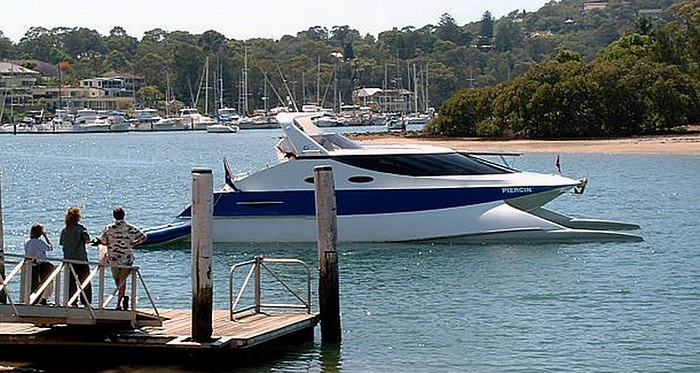
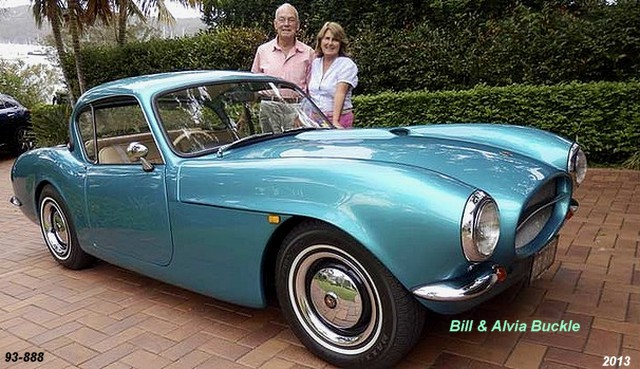
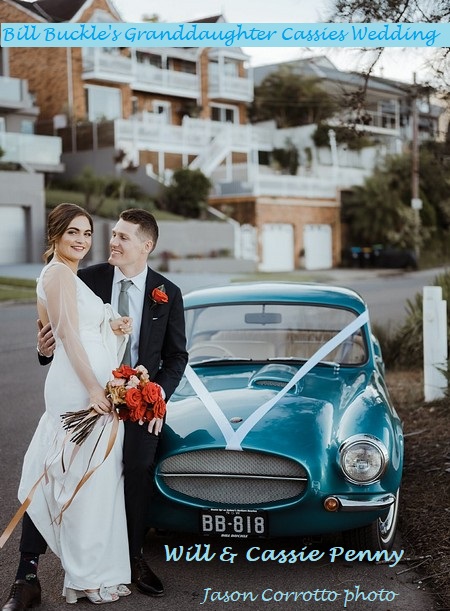



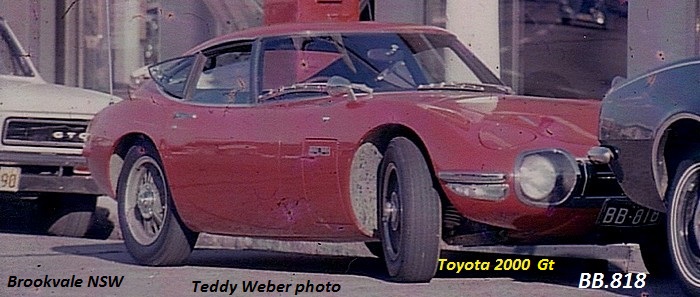

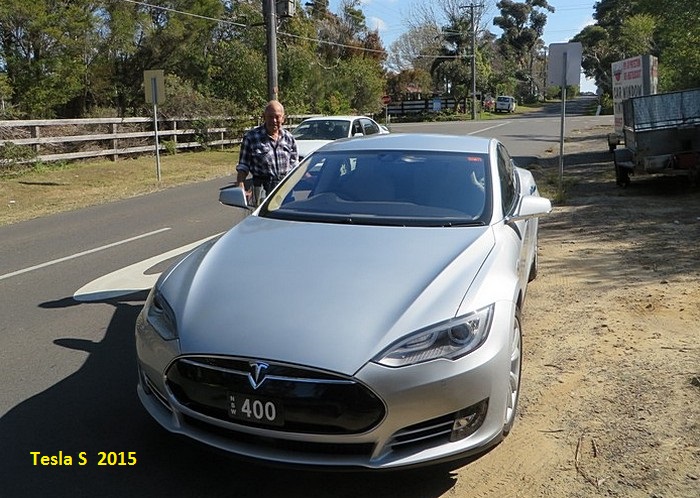
Bill Buckle and a few of his mates ---------------------------------------------------- Bill at a Buckle Coupe advertising photo shooting
Motor Torgue with David Berthon
Submitted by Richard Admin Palmer on Tue, 2013-01-22 09:52
Buckle - Coupe de Grace
For 86-year old Bill Buckle entry in the Concours d'Elegance Prestige O'blige in last Saturday's CARnivale during the Australia Day celebrations in Sydney's CBD with his Buckle sports coupe brought back a host of memories for the car industry veteran.
Back in 1956 the then 29-year old enterprising and innovative Sydney-sider captured the local car market with a new lightweight sports coupe that would literally blitz the opposition on the race track.
Buckle had started in the family's growing automotive dealership in William Street, Sydney following the untimely death of his father in 1947 despite having already commenced an engineering apprenticeship as a fitter and turner.
The dealership had thrived on the post-war import and boom of the new breed of British cars like Armstrong Siddeley and the German brands of Borgward and Goliath and the American DeSoto. In 1949 Buckle Motors also added the Citroen franchise, the French company having leapt to worldwide popularity with the impressive new light 15 model.
Starting in the spare parts department Buckle quickly moved into service and then sales. From there it didn't take him long to spurn an interest in motorsport and he posted many successes at Mount Druitt and Bathurst.
With the business under the watchful eye of his father's protégé and retail industry stalwart Bill Lowry, a young and enthusiastic Buckle was able to spend time racing and rallying a Citroen Light 15 as well as design and build an open-wheel race car based on a Light 15 wreck.
However, anxious to travel and see what the automotive world had to offer he sold the unfinished project and headed overseas. Quickly moving in racing circles Buckle became a regular at Grand Prix and other club events and was invited to drive a Light 15 Citroen in RAC events.
Spending the best part of 1952 and 53 overseas had given him plenty of time to look at emerging trends in the motor industry. "I saw some new fibreglass-bodied sports cars at the Earl's Court Motor Show in 1953. They were a bit crude and I thought Hell, I can do better than that."
Lured back to Australia by Laurie Whitehead to co-drive a Light 15 Citroen in the 1953 Redex Trial Buckle was quick to take up the idea of building a lightweight sports car with Bill Lowry.
By now Buckle Motors was a public company. "Fortunately, Bill Lowry was able to convince the board that my dream should become a reality and that the investment was worthwhile." And so the Buckle Coupe was born.
After setting up shop in the company's distribution warehouse at Punchbowl Buckle, with the help of his old school pal Charles Buck, got to work on the prototype, stripping a brand new 2.6-litre six-cylinder Ford Zephyr sedan of its mechanicals and selling off the body.
"We settled on the 2.6-litre Zephyr engine because Ford would sell us new parts whereas Holden wouldn't. Looking back, I'm glad we chose Ford mechanicals because I think they were better suited to the job."
According to Buckle "There was no real design drawing of this new car, I just built a chicken wire frame initially to get the shapes, covered it with hession and then laid a plaster cast over it until I was happy." The plaster cast was used to form the lightweight 3-5mm. thick fibreglass body shell, in many ways a full monocoque with full fibreglass floor, incorporating a fully-hinged bonnet, grille and front guards.
Through racing, Buckle had met Ron Tauranac, the then relatively unknown engineer and race mechanic who had made a name for himself building some impressive hill climb cars. Tauranac would design a box section chassis for the car featuring a transverse leaf spring at the front complimented with semi-elliptics at the rear. Of course, Tauranac would go on to gain much international fame in race car design working with Jack Brabham on his early open-wheelers as well as many others.
The prototype Buckle convertible with detachable roof made its public debut at the 1955 Sydney Motor Show making the front cover of Wheels Magazine in October that year.
Despite introducing a number of innovative features including push button door locks, an adjustable steering column and a fold down rear seat to increase boot space the frontal styling with its 'gaping-mouth' grille was not well received, enough to convince Buckle he needed to make some fundamental design changes.
The first production Buckle Coupe was ready the following year with much more appealing lines and was well received.
With an all up weight of just 860 kilos it had an impressive power to weight ratio and immediately started to post a number of race successes.
Buckle had tweaked the standard Ford Zephyr "six" boring it out to 3-litres and fitting a Raymond Mays head while the standard three-speed Zephyr gearbox was fitted with Laycock de Normanville overdrive, which according to him, gave the sportster "a superb set of ratios."
The lightweight fibreglass sportsters performance was surprising, Buckle even cleaning up one of two highly prized Aston Martin DB3S's at the Gnoo Blas circuit in Orange in 1959, posting 200km/hour down that circuits long straight.
This race success still has fond memories for Buckle "The win over the Kangaroo Team Aston was particularly satisfying as the car was my daily set of wheels and driven to the circuit whereas the Aston's were trailered. What's more, I had towed another car to the circuit with it, the tow bar causing some initial consternation with the scrutineers."
The Buckle Coupe would prove enormously successful in the hands of its maker and a number of competition drivers, posting every hill climb record in the GT Class plus many lap records including those at Bathurst, Orange, Catalina Park, Sandown and Lowood.
However, despite enormous recognition on the circuit it didn't translate to the showroom and, as Buckle concedes, "the exercise commercially was not a success, we only built 20 but that didn't matter, it was a great experience and 16 of those competed in motor sport."
However, the innovative designer from Sydney's northern beaches would go on to have enormous success with his next project, the Goggomobil.
With the market at this time demanding a small inexpensive car Buckle imported two of the small German-built four-door sedans for evaluation in late 1956 with the view to gaining the import license.
The following year he went to see the maker Hans Glas Gmbh, with the view to importing the major components but substituting the steel body with a locally built glass-fibre unit. With Buckle's experience in glass fibre construction the local twin-cylinder 300cc two-stroke air-cooled two-door Goggomobil sedan became an instant hit.
A Coupe variant followed while the celebrated Dart convertible was icing on the cake and around 5000 were eventually sold before the BMC Mini took the world by storm and according to Buckle "literally killed off the local Goggo project overnight"
Fifty years on after selling off his extensive retail car empire in Brookvale Bill Buckle can reflect on a very successful automotive career.
Following his successful racing involvement he lost track of his clutch of Coupes apart from a repossession offered to him in the late 1960's by an acquaintance in the finance industry. "My son, Bill junior pulled it apart, put it in boxes and stored it in one our factories. When we moved from there somebody looked at some of the parts, didn't know what they were and threw some of them out."
Buckle's renewed interest in his early cars was sparked a few years back by a lecture he was asked to give at Sydney's Powerhouse Museum about building cars in Australia 60 years ago. "The museum has had a Goggomobil Dart for some years, I also have several nice ones so they thought it would be good to get a Buckle there as well."
"I knew of one in Lithgow so I rang the bloke and asked if he would bring it down - when I saw it it was just so beautiful and I thought I should really own one. Not getting any younger I made the bloke an offer he couldn't refuse."
Highly satisfied at getting one of his rare coupes back Buckle was then inspired to finish the car he'd had in boxes. When I bought the complete car it had a few spares and what with other parts I was able to source I have been able to fully restore the first car as well."
"It wasn't an easy restoration, the body had had more hits than the Beatles but I gave the car to a fibreglass boat builder and it's come up fine." Bill's latest restoration is painted in the colour of his first production car, a pale green metallic with bone trim.
Driving both cars, production numbers 14 and 16, I was surprised at their overall stiffness. Both feature standard 2.6-litre Zepyhr engines, the red car with five-speed Toyota gearbox, the blue car with four-speed Borg Warner and overdrive - both transmissions providing a more relaxed performance to the original three-speed Ford unit.
Both cars are free of rattles and offer an exhilarating period performance from the relatively "lusty" six.
Whilst a number of owners have upgraded to front disc brakes Buckle has maintained the standard 10-inch Ford drums and they are more than effective on this light weight coupe.
Back in 1955 this home grown sports coupe must have been a sensational performer against the more mundane production cars of the day.
FAST FACTS
Price new - 1875 pounds
Engine - Six-cylinder 2553cc.
Transmission - three-speed manual
Chassis - Box section with tubular and box cross members.
Steering - Worm and peg
Brakes - 10-inch drums servo-assisted
0 to 100 km/h - 11.4 seconds
Top Speed - 190 km/h
Wheels - 13 x 7 steel rims
TIME TO REFLECT
Having just reached 86 years Bill Buckle looks back with a sense of pride at his pioneering achievements with glass fibre body construction in the 1950's. 'I also look back with a degree of trepidation when you consider we were doing 130mph down a tree-lined Conrod Straight at Bathurst in these cars with nothing but a lap belt."
Buckle also believes he is one of a rare breed of car collector today - "how many people who manufactured cars in the 1950's have then set about restoring some examples 60 years later. I must be mad."
How does he feel about his design today? "You know, I get a lot of comments about the body - I think it's still a very smart looking coupe and has aged well. We learnt from the prototype and the production car turned out pretty well considering there were no design drawings."
Of the 20 Buckles produced a surprising number are still in existence and there is strong following with one owner, Bob Williamson, setting up a website and a register of owners. Williamson has owned three Buckles at different times over more than 50 years and bought his first aged 19. As Buckle enthuses, "it been really nice to take in the enthusiasm for my car from really nice people and we have really enjoyed a number of events together."
He's particularly stoked that the original prototype Buckle convertible with detachable roof is still in existence. "We stripped the mechanicals to use in the first production car and sold the rest in 1958 to a guy in Canberra. He re-built it and it then passed through three other owners before going to New Zealand and the U.K. - it's now owned by a German enthusiast so I guess you could say it really has become a true International model."
As we chat I look over Pittwater and note a very smart 15-metre cruiser moored in front of Buckle's Bayview home. "That's Wildcat, a catamaran that I designed myself and I'm rather proud of the design of the wave breaker hull"
Just another example of Bill Buckle's innovative mind still going strong long after his celebrated Coupe hit the road.
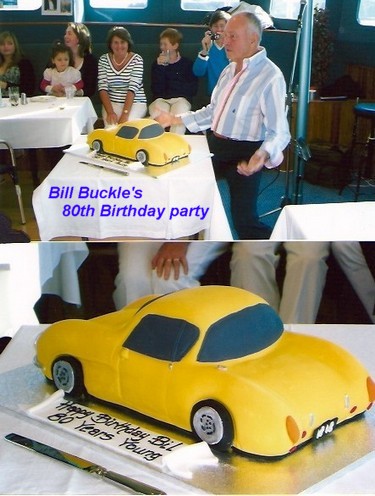

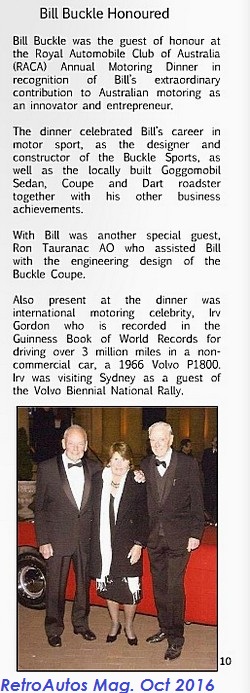 |
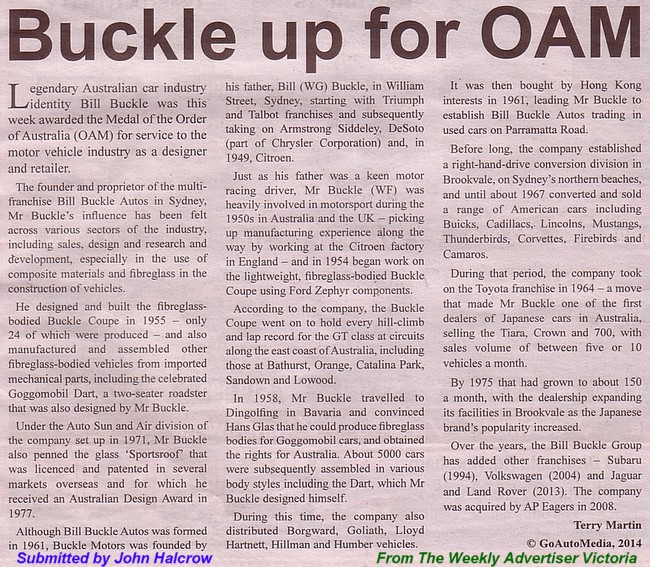 |
********************
Stable of Speed interview with Bill Buckle
https://www.youtube.com/watch?v=Iq8E4qjn4co
*****************************************
From 2GB radio 9/8/15
http://www.2gb.com/article/motor-torque-bill-buckle-oam
*************************************
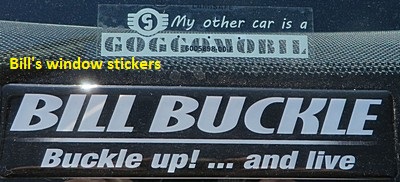
|




